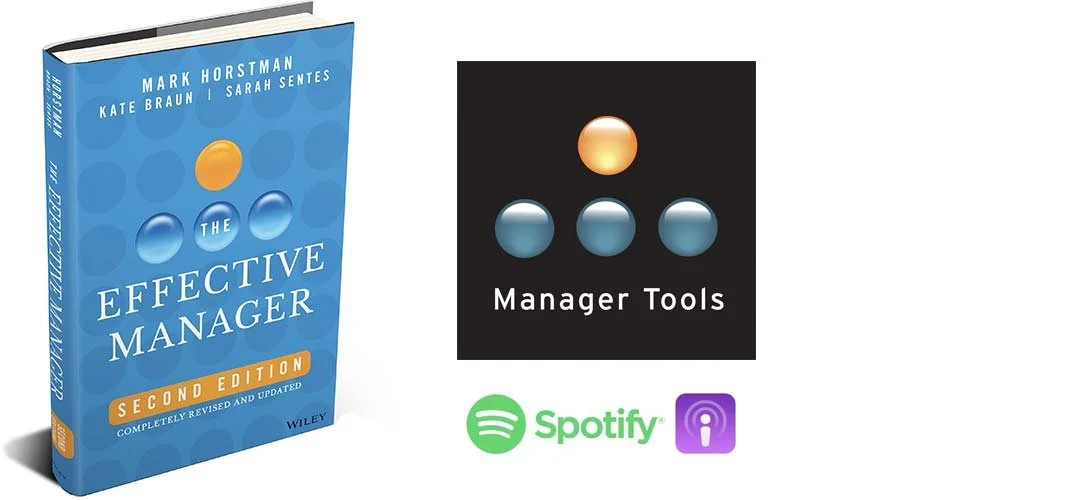The 4 Tools Managers Need to Be Effective
Learn the four proven tools every manager needs to lead effectively: One-on-Ones, Feedback, Coaching, and Delegation. Based on The Effective Manager book by Mark Horstman.
Running a team is one of the hardest parts of growing a business.
Most small business owners can wrap their head around being the leader: setting the vision, communicating direction, inspiring their team. But when it comes to being the manager, that’s where things get more difficult.
Managing people, holding them accountable, and driving performance while keeping a healthy team culture isn’t easy, and most owners were never taught how to do it.
As Mark Horstman explains in The Effective Manager, the job of a manager is to get results and keep your people.
Simple idea. Hard to implement.
At Leader Guide, we love simple, practical tools and frameworks that help small business owners grow. We came across the book The Effective Manager by Mark Horstman, Kate Braun and Sarah Sentes - and instantly connected with it. This would be one of the clearest, most practical teachings we’ve seen for helping managers do both parts of the job well: delivering results and building teams that stay.
The book outlines four core tools every manager needs to be effective. These tools have been tested on hundreds of thousands of managers over 20 years.
Let’s walk through each one and how you can apply them in your business. Pick up the book or listen to their podcast (over 1,000 episodes!) for a deep dive into each of these tools:
1. One-on-Ones
If you only implemented one thing from The Effective Manager, this would be it.
One-on-ones (or O3s) are 30-minute weekly meetings between you and each team member that reports directly to you. They’re not status updates or mini-performance reviews, they’re conversations that build trust, clarity, and accountability.
The format is simple:
The first 10 minutes are for them.
The next 10 minutes are for you.
The last 10 minutes are for the future. (if time permits)
That’s it.
These meetings give your team regular access to you, and give you real visibility into what’s going on in the business. Over time, they become the heartbeat of healthy management, where communication flows both ways and relationships grow stronger through increased trust.
Most managers skip this step, thinking they don’t have time. But the truth is, you can’t afford not to do them. When one-on-ones are done consistently, people feel seen, problems surface early, and performance naturally improves.
“The most important behaviour a manager can engage in is getting to know her people.” - Mark Horstman
If you want to retain your best people, start here. A half-hour a week builds more trust and productivity than any team lunch ever could.
2. Feedback
People can’t improve what they can’t see. And when they don’t hear anything from their manager, they start guessing… Which usually leads to frustration or confusion.
In many small businesses, feedback is either avoided or dumped in big doses once a year at performance reviews. Both approaches fail. People can’t improve if they don’t know what to adjust.
The purpose of feedback is to encourage effective future behaviour. Once you understand that purpose, everything changes. You stop focusing on what went wrong and start guiding people toward what can go right.
The Effective Manager model simplifies it beautifully. Every feedback conversation has four quick steps:
Ask if you can give feedback.
This keeps the conversation respectful and gives the other person a moment to focus.
Example: “Hey, can I give you some quick feedback?”
Describe the behaviour.
Stick to facts, not feelings. Be specific about what you saw or heard.
Example: “When you sent the client update two days late…”
Describe the impact.
Help them connect the dots between what they did and what happened next.
Example: “…it caused the project team to scramble at the last minute to get approvals.”
Encourage or correct the future behaviour.
End with a clear signal of what you’d like to see next time, or have them come up with a plan of how it could be done better.
Example: “Can you make sure future updates go out on schedule? It helps everyone stay on track.”
That’s it. Short, calm, specific.
It might sound formulaic, but it works because it keeps emotion out and focuses on facts.
And here’s the beauty — you use the same model for positive feedback too. “When you followed up with that client the same day, it made us look organised and proactive — great job.”
When someone does something well, reinforce it immediately. When something’s off, call it out early before it grows. If feedback only appears when something’s wrong, it will always feel like criticism. But when it happens regularly, and includes both positive and corrective examples, it becomes a normal and natural rhythm of your workplace.
3. Coaching
Coaching is how you help your people get better over time. It’s about growing their confidence and capability so they can think, decide, and perform without you. Many business owners fall into two traps: they either jump in and fix the problem themselves, or they give vague advice like “try harder next time.” Neither builds capability.
Coaching is about helping someone learn and self-improve, not telling them what to do.
In The Effective Manager, coaching follows four steps:
Collaborate on a goal – agree on a specific skill or behaviour or outcome to improve.
Collaborate on resources – find what tools, examples, or support can help.
Collaborate on a plan – create clear steps to achieve the goal.
Collaborate on follow-up – set out how to review progress with accountability.
Notice the word “collaborate” in every step. Coaching isn’t done to people, it’s done with them.
You don’t need to be an expert in everything your team does. You just need to guide them to clarity, help them practise, and hold them accountable. Coaching is how you turn good employees into great ones.
It also changes how your team sees you: not as the person who always has the answers, but as the leader who helps them find their own.
4. Delegation
Delegation is how you multiply yourself.
It’s one of the hardest skills for small business owners to learn because it feels faster to just do things yourself. But that mindset keeps you stuck in operator mode forever.
Delegation is about growth for you and your team. It’s how you build trust, develop capability, and free yourself to focus on higher-value work (see The Offload Loop).
Here’s some steps to help you delegate:
What – Clearly state what you’re delegating. The specific task, project, or outcome.
Why – Explain why it matters. Link it to team goals, business priorities, or their development.
How Much – Define the authority level. Mark gives three common levels:
“Do exactly what I ask and report back.”
“Make the decision, then tell me what you did.”
“Make the decision and you don’t even need to tell me.”
When – Agree on when it’s due and how (or if) you’ll check in.
Start small. Hand off one recurring task you shouldn’t be doing, and coach them through it. Expect it to take longer at first. That’s okay. You’re building independence. Over time, you’ll not only get your time back, you’ll have a stronger, more capable team around you.
Using these tools to manage effectively
These four tools: one-on-ones, feedback, coaching, and delegation all work together to form a simple management system that helps you do exactly what every small business owner wants to do: get results and keep your people.
One-on-ones build trust and visibility.
Feedback creates clarity and accountability.
Coaching drives growth.
Delegation builds scale.
These tools aren’t meant to be rigid rules or scripts to follow word for word. Mark Horstman makes it clear that what matters most are the behaviours behind them: knowing your people, talking about performance, asking for more, and pushing work down.
Every business and team will apply these ideas a little differently depending on its size, culture, and stage. What’s important is that you build a system that’s teachable, sustainable, and consistent over time.
The names of the tools are just shorthand, not sacred. Use them as a foundation, adapt them to your context, and you’ll become the kind of manager who both gets results and keeps great people.
This Insight was inspired by and contains frameworks from 'The Effective Manager: Completely Revised and Updated', Mark Horstman with Kate Braun and Sarah Sentes, Wiley 2023.
Written by Lachlan Nicolson




